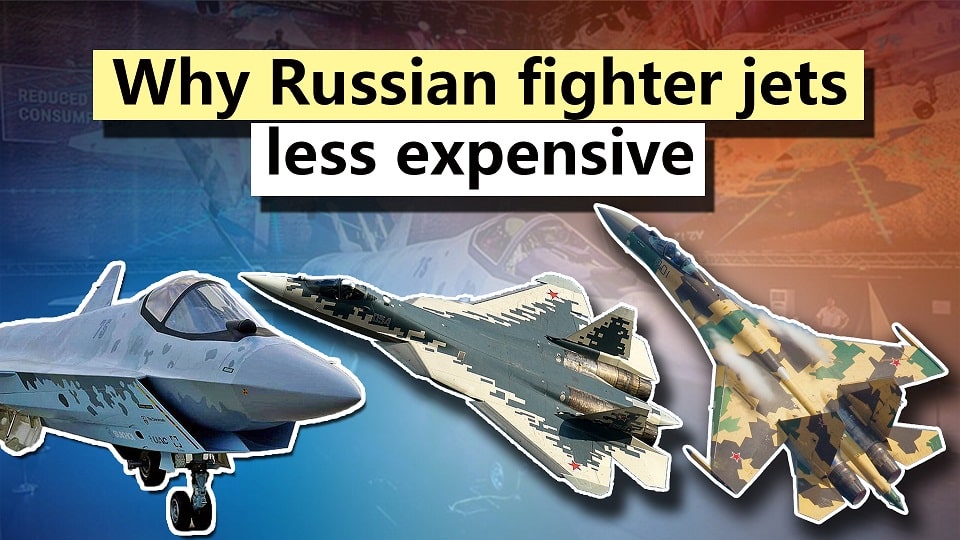Aerospace
Why are Russian fighter jets ten times cheaper than American fighter jets?

The cost disparity between Russian and American fighter jets is an intricate topic influenced by various factors. While the claim that Russian fighter jets are ten times cheaper than American ones is not entirely accurate, there are indeed significant differences in pricing between the two nations’ aircraft.
In this article, we will delve into the key reasons behind this cost disparity, taking into account factors such as technology, production methods, procurement processes, and the overall strategic objectives of each country’s military. By examining these factors, we can gain a better understanding of why Russian fighter jets are often more affordable than American ones and the implications this has on the global defense industry.
Labor Costs: One significant factor contributing to the cost disparity between Russian and American fighter jets is the difference in labor costs between the two countries. Labor costs in Russia are generally lower than in the United States. This can affect the overall cost of manufacturing military equipment, including fighter jets.
Currency Exchange Rates: Another factor that can impact the perceived cost of Russian fighter jets is currency exchange rates. Fluctuations in exchange rates between the Russian ruble and the U.S. dollar can play a significant role in determining the affordability of Russian military exports for foreign buyers.
Technology and Features: American fighter jets often incorporate more advanced technology and features, which can drive up their cost significantly. These technologies can include advanced radar systems, stealth capabilities, and more sophisticated avionics.
Manufacturing Infrastructure and Quality: The Western military-industrial complex benefits from decades of investment in advanced manufacturing infrastructure and quality control mechanisms. This infrastructure enables economies of scale, efficient production processes, and consistent high-quality output. On the other hand, the Russian military-industrial complex may not be as technologically advanced or efficient in its manufacturing processes, potentially resulting in lower production costs.
Russian Economic Factors: The overall health of the Russian economy is a critical determinant of the pricing of Russian fighter jets. Economic conditions, including currency exchange rates, and inflation, can influence the affordability and competitiveness of Russian military exports.
A robust Russian economy could provide the necessary resources to improve manufacturing infrastructure and invest in technological advancements. However, economic challenges may limit the government’s ability to increase subsidies or support the growth of its defense industry. Many improvements in Russian aircraft manufacturing, such as those seen in Sukhoi and to a lesser extent Mikoyan (MiG), have largely been self-funded by these companies.
while Russian fighter jets may sometimes appear significantly cheaper than American counterparts, this pricing discrepancy arises from a combination of factors, including technological disparities, market dynamics, manufacturing infrastructure, and economic conditions. The pursuit of excellence and the incorporation of cutting-edge technology in Western fighter jets contribute to their higher costs, while market forces and varying levels of technological advancement play a role in the perceived affordability of Russian fighter jets.

Aerospace
When Ratan Tata was denied entry to the airfield at the Aero India show, he waited

During our visit to Aero India 2019, we had the unexpected opportunity to see Ratan Tata at the event, which was a thrilling moment for us. However, there was a surprising hiccup when the security staff didn’t allow him to enter due to a lack of a security pass.
Despite this, he remained calm and patiently waited for about 20 minutes until a member of the Tata team brought him the required pass, after which he calmly proceeded inside. It was a humbling sight, showcasing his composed demeanor even in such situations.
Ratan Tata ji is not only a renowned industrialist but also a trained pilot, holding a pilot’s license. In 2007, he became the first Indian civilian to fly the F-16 Falcon during the Aero India show in Bangalore—a proud moment for the nation.
His passion for aviation extended beyond flying, as he played a key role in shaping India’s aerospace industry. Under his leadership, Tata ventured into manufacturing and maintaining aerospace components while upholding its legacy of quality. Notably, Tata’s collaboration with Airbus to develop and manufacture the C295 aircraft is a testament to its growing influence in the sector.
-

 Aviation2 months ago
Aviation2 months agoMicrosoft Flight Simulator Raises $3 Million to Bring Back the An-225 Mriya
-

 Airlines2 months ago
Airlines2 months agoQantas Engineers Stage Walkout Over Cost of Living Concerns
-

 Airlines2 months ago
Airlines2 months agoQatar Citizens Can Travel to the United States Without a Visa
-

 Aviation2 months ago
Aviation2 months agoQatar Airways bans these new Electronic Devices on plane
-

 Airlines2 months ago
Airlines2 months agoJapan Airlines Rolls Out Free Domestic Flights to International Passengers
-

 Defence2 months ago
Defence2 months agoWhich Country Has the Largest Fleet of Fighter Aircraft?
-

 Airport2 months ago
Airport2 months agoWestern Sydney Airport Welcomes Its First Plane After 6 Years of construction
-

 Aviation2 months ago
Aviation2 months agoDid you know ? Once Boeing 747 carried 1088 passenger in 1991








